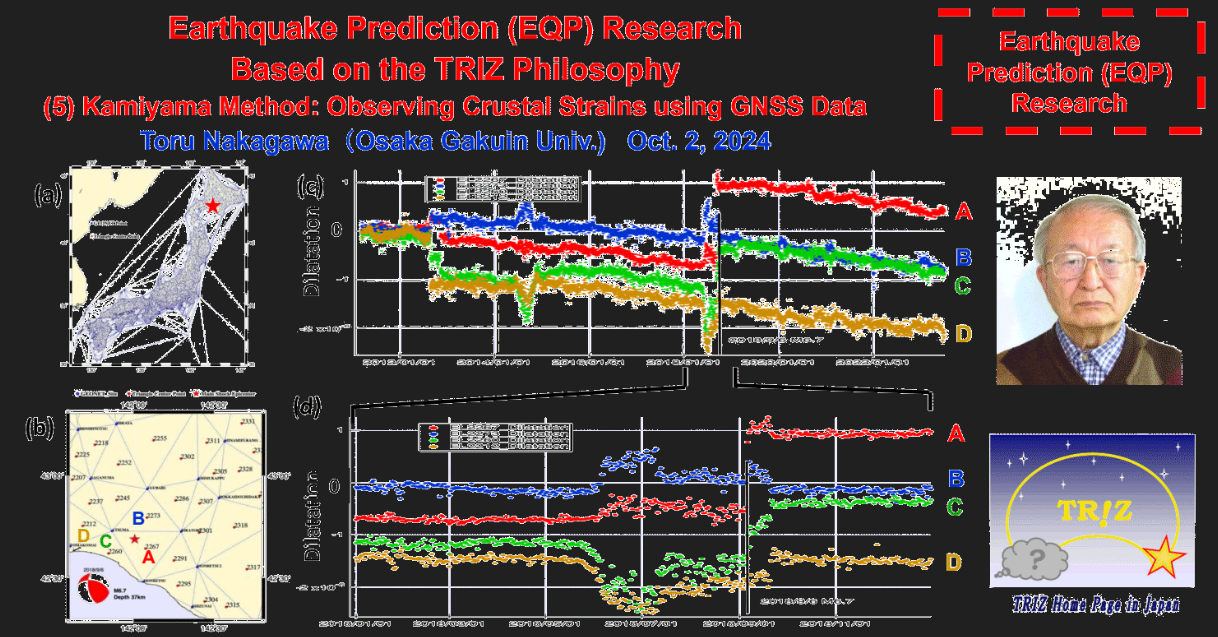Updated: 7 October 2024

Toru Nakagawa (OGU, WTSP Project Leader) "TRIZ Home Page in Japan":
http://www.osaka-gu.ac.jp/php/nakagawa/TRIZ/eTRIZ/
-----------------------------------------------
Hello, how are you?
Subject:
"Earthquake Prediction (EQP) Research Based on the TRIZ Philosophy:
(5) Kamiyama Method: Observing Crustal Strains using GNSS Data
(Toru Nakagawa) (LinkedIn, Oct. 3, 2024) "TRIZ Home Page in Japan" in English (Oct. 7, 2024)
in Japanese (Oct. 7, 2024)
Please see the figure, attached here.
Makoto Kamiyama (Professor Emeritus, Tohoku Institute of Technology)
et al. presented a paper at the EPSJ (Earthquake Prediction
Society of Japan) Conference in Dec. 2023.
They use the precise location data of about 1300 reference points
throughout Japan, which are measured and updated daily by the
Geospatial Information Authority of Japan using the DNSS satellite.
Kamiyama et al. use the triangular FEM mesh to derive the
maximum shear strain and the area strain (dilatation) coefficients
for each triangular area.
Detailed data and their analysis are reported for Hokkaido Iburi
East EQ (Sept. 6, 2018, MJ 6.5).
The dilatation coefficients of four triangle areas around the
epicenter is plotted daily against the time axis from 2011 to 2023.
The four areas initially shrank slowly at the same rate,
then at the EQ two areas suddenly expanded, and
after the EQ all four areas shrank slowly again as before.
Zooming in to the year 2018, abnormal variations of the
dilatation coefficients suddenly appear 3 months before the EQ.
Two areas vary positively while two others vary negatively;
but, regardless of the direction, the variation patterns are very similar.
The variation started to increase 3 months before the EQ,
reached its peak, and slowly decreased in an unstable manner,
then changed suddenly at the EQ, and disappeared a few days after the EQ
Similar abnormal pre-EQ variations were observed in all 3 EQs in the paper.
Using these precursors, we can estimate
the seismic region and magnitude of the coming EQ on the basis
of the number and extent of areas showing such abnormal variations.
As for the timing of the coming EQ, we learn the cases of 3 years to 3 months,
but have not yet found any further indicators of the occurrence of EQs.
The Kamiyama Method is now considered the most useful and
promising for Short-term EQ Prediction.
We should observe and analyze many more EQs to refine the method.
------
We sincerely hope your understanding and support of our
approach to the Earthquake Prediction Research.
Please contribute your comments, thoughts, etc.
I will post them in our EQP Forum on my website.
Let's work Together! Connected !!
Best wishes,
Toru
--------------------------
Toru Nakagawa, Dr., Professor Emeritus, Osaka Gakuin University
E-mail: This email address is being protected from spambots. You need JavaScript enabled to view it. [Main email address. For receiving.]
This email address is being protected from spambots. You need JavaScript enabled to view it. [For sending (& receiving)]
This email address is being protected from spambots. You need JavaScript enabled to view it. [For sending Update Announcements] Editor of the "TRIZ Home Page in Japan":
https://www.osaka-gu.ac.jp/php/nakagawa/TRIZ/eTRIZ/">URL:https://www.osaka-gu.ac.jp/php/nakagawa/TRIZ/eTRIZ/
Project Leader of World TRIZ-related Sites Project (WTSP) Director of CrePS Institute:
Publication of "TRIZ Practices and Benefits" book series (in Japanese)
3-1-13 Eirakudai, Kashiwa, Chiba 277-0086, Japan.
Phone & FAX: +81-4-7167-7403
------------------------------------------
